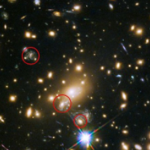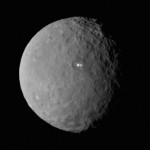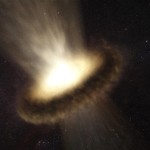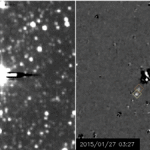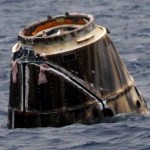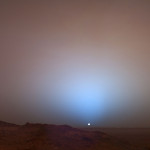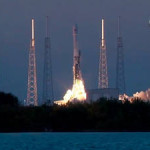Hubble May Have Clues About Dark Matter
Using observations from NASA’s Hubble Space Telescope and Chandra X-ray Observatory, astronomers have found that dark matter does not slow down when colliding with itself, meaning it interacts with itself less than previously thought.
Researchers say this finding narrows down the options for what this mysterious substance might be.
Dark matter is an invisible matter that makes up most of the mass of the universe. Because dark matter does not reflect, absorb or emit light, it can only be traced indirectly by, such as by measuring how it warps space through gravitational lensing, during which the light from a distant source is magnified and distorted by the gravity of dark matter.
To learn more about dark matter and test such theories, researchers study it in a way similar to experiments on visible matter — by watching what happens when it bumps into other objects. In this case, the colliding objects under observation are galaxy clusters.
Researchers used Hubble and Chandra to observe these space collisions. Specifically, Hubble was used to map the distribution of stars and dark matter after a collision, which was traced through its gravitational lensing effect on background light. Chandra was used to detect the X-ray emission from colliding gas clouds. The results are published in the March 27 edition of the journal Science.
“Dark matter is an enigma we have long sought to unravel,” said John Grunsfeld, assistant administrator of NASA’s Science Mission Directorate in Washington. “With the combined capabilities of these great observatories, both in extended mission, we are ever closer to understanding this cosmic phenomenon.”
Galaxy clusters are made of three main ingredients: galaxies, gas clouds, and dark matter. During collisions, the gas clouds surrounding galaxies crash into each other and slow down or stop. The galaxies are much less affected by the drag from the gas and, because of the huge gaps between the stars within them, do not slow each other down.
“We know how gas and stars react to these cosmic crashes and where they emerge from the wreckage. Comparing how dark matter behaves can help us to narrow down what it actually is,” said the study’s lead author David Harvey of the École Polytechnique Fédérale de Lausanne (EPFL) in Switzerland.
Harvey and his team studied 72 large cluster collisions. The collisions happened at different times and were viewed from different angles — some from the side, and others head-on.
The team found that, like the galaxies, the dark matter continued straight through the violent collisions without slowing down much. This means dark matter does not interact with visible particles and flies by other dark matter with much less interaction than previously thought. Had the dark matter dragged against other dark matter, the distribution of galaxies would have shifted.
“A previous study had seen similar behavior in the Bullet Cluster,” said team member Richard Massey of Durham University in the United Kingdom. “But it’s difficult to interpret what you’re seeing if you have just one example. Each collision takes hundreds of millions of years, so in a human lifetime we only get to see one freeze-frame from a single camera angle. Now that we have studied so many more collisions, we can start to piece together the full movie and better understand what is going on.”
With this discovery, the team has successfully narrowed down the properties of dark matter. Particle physics theorists now have a smaller set of unknowns to work around when building their models.
“It is unclear how much we expect dark matter to interact with itself because dark matter already is going against everything we know,” said Harvey. “We know from previous observations that it must interact with itself reasonably weakly.”
Dark matter may have rich and complex properties, and there are still several other types of interactions to study. These latest results rule out interactions that create a strong frictional force, causing dark matter to slow down during collisions.
The team also will study other possible interactions, such as dark matter particles bouncing off each other like billiard balls and causing dark matter particles to be ejected from the clouds by collisions or for dark matter blobs to change shape. The team also is looking to study collisions involving individual galaxies, which are much more common.
“There are still several viable candidates for dark matter, so the game is not over. But we are getting nearer to an answer,” said Harvey. “These astronomically large particle colliders are finally letting us glimpse the dark world all around us, but just out of reach.”
The Hubble Space Telescope is a project of international cooperation between NASA and ESA (European Space Agency). NASA’s Goddard Space Flight Center in Greenbelt, Maryland, manages the telescope. The Space Telescope Science Institute (STScI) in Baltimore conducts Hubble science operations. STScI is operated for NASA by the Association of Universities for Research in Astronomy, Inc., in Washington.
NASA’s Marshall Space Flight Center in Huntsville, Alabama, manages the Chandra program for NASA’s Science Mission Directorate in Washington. The Smithsonian Astrophysical Observatory in Cambridge, Massachusetts, controls Chandra’s science and flight operations.

